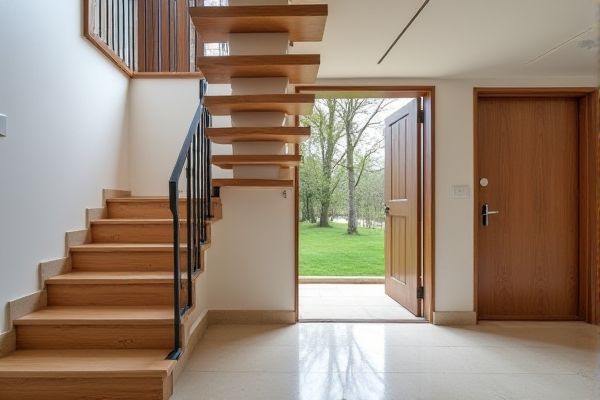
External staircases offer space-saving benefits and enhance outdoor accessibility, while internal staircases provide seamless connection within your home's layout and contribute to interior aesthetics. Explore the rest of the article to discover which staircase type best suits your design needs and personal preferences.
Table of Comparison
| Feature | External Staircase | Internal Staircase |
|---|---|---|
| Location | Outside the building | Inside the building |
| Weather Exposure | Exposed to elements (rain, snow, sun) | Protected from weather |
| Material Durability | Requires weather-resistant materials (metal, treated wood) | Can use standard indoor materials (wood, concrete) |
| Security | Higher risk, needs security features | More secure, limited access |
| Space Utilization | Frees internal space | Consumes internal space |
| Maintenance | Regular maintenance due to weather impact | Lower maintenance requirements |
| Cost | Usually lower initial cost | Typically higher construction cost |
| Aesthetics | Visible and impacts building exterior | Integrated with interior design |
| Safety | Slippery in wet conditions | Safer in controlled environment |
Introduction to Staircases: External vs Internal
External staircases are designed to withstand weather conditions and often feature materials like steel, concrete, or treated wood for durability and safety. Internal staircases prioritize aesthetic appeal and space efficiency, typically constructed with hardwood, carpet, or tiles to complement interior design. Both types require adherence to building codes regarding dimensions, railing height, and load capacity to ensure user safety.
Key Differences Between External and Internal Staircases
External staircases are designed to withstand outdoor weather conditions, using durable materials like treated wood, metal, or concrete, while internal staircases prioritize aesthetic integration with interior design and commonly use wood, carpet, or polished stone. External stairs often have open risers to allow water drainage, contrasted with enclosed risers in internal staircases for safety and comfort. Load-bearing requirements differ significantly, with external staircases requiring robust structural support to resist environmental stress, whereas internal staircases focus more on space efficiency and architectural style within the building.
Advantages of External Staircases
External staircases offer enhanced safety by providing alternative escape routes during emergencies such as fires, reducing risk of indoor hazards. They maximize indoor space utilization by eliminating the need for indoor stairwells, allowing for more flexible interior layouts. These staircases also improve ventilation and natural light access to the building's upper floors, contributing to energy efficiency and occupant comfort.
Benefits of Internal Staircases
Internal staircases enhance your home's security and privacy by restricting access to outside elements and limiting entry points. They contribute to energy efficiency by reducing heat loss compared to external staircases exposed to weather conditions. Additionally, internal staircases offer greater protection from environmental damage, requiring less maintenance and increasing the overall durability of your home's structure.
Design Considerations for External Staircases
External staircases require weather-resistant materials such as galvanized steel, concrete, or treated wood to withstand environmental elements and prevent corrosion or decay. Proper drainage and non-slip surfaces are essential to ensure safety in wet or icy conditions, while structural support must account for varying loads and thermal expansion. Compliance with local building codes regarding handrails, riser height, and tread depth is crucial to guarantee accessibility and durability.
Safety and Security Aspects
External staircases offer enhanced fire safety by providing a direct escape route outside the building, reducing smoke inhalation risks during emergencies. Internal staircases, while more secure from weather exposure and unauthorized access, require additional safety features like fire-resistant materials and smoke alarms to ensure occupant protection. You should evaluate the building's design and security needs to choose the safest option for your specific environment.
Cost Comparison: External vs Internal Staircases
External staircases generally cost less to install than internal staircases due to simpler structural requirements and reduced need for complex finishes or integration with indoor layouts. Material choices for external stairs, such as concrete or metal, often provide durability and lower maintenance expenses, further reducing long-term costs compared to wood or ornate internal staircases. Internal staircases typically involve higher labor costs for framing, drywall, and finishing, which can significantly increase overall project expenses.
Maintenance Requirements
External staircases require more frequent maintenance due to exposure to weather elements such as rain, snow, and UV rays, which can cause material deterioration, rust, or wood rot. Internal staircases have lower maintenance needs since they are protected from environmental damage, requiring primarily periodic cleaning and occasional repairs to finishes or structural components. Choosing materials like treated wood or metal with protective coatings can help reduce upkeep for external stairs.
Aesthetic Impact on Building Architecture
External staircases create a striking visual element that can enhance a building's facade with modern or industrial aesthetics, often serving as architectural focal points. Internal staircases contribute to a cohesive interior design, blending seamlessly with the building's style and promoting spatial flow. The choice between external and internal staircases significantly influences the overall architectural character and perception of the building's design.
Choosing the Right Staircase for Your Property
External staircases provide durable access solutions ideal for outdoor environments, offering weather-resistant materials such as galvanized steel or treated wood that withstand harsh conditions. Internal staircases enhance interior design and space efficiency, featuring a variety of styles from spiral to straight runs that complement your home's aesthetics and functionality. Your choice depends on factors like space availability, climate, and whether the staircase serves as a primary or secondary access point.
 homyna.com
homyna.com